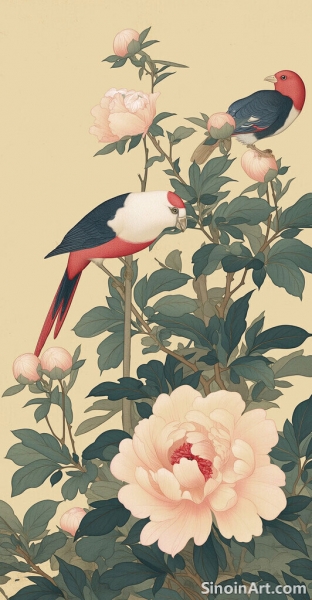Gongbi vs. Xieyi: Contrasting Styles in Chinese Art
|
Article:  One of the fascinating aspects of Chinese painting is the duality between the meticulous precision of Gongbi and the expressive freedom of xieyi. Understanding the differences between these two major styles is essential for appreciating the diversity and depth of Chinese artistic traditions. While both are rooted in the same cultural heritage, they offer distinct approaches to capturing the world around us.  Gongbi, as previously discussed, emphasizes precise detail and realistic representation. Every line, every color wash, is carefully planned and executed. The focus is on creating a faithful likeness of the subject, highlighting its intricate details and textures. It is a style that demands patience, meticulous planning, and a mastery of the brush. The end result is a painting that showcases both technical proficiency and artistic vision.  In contrast, xieyi, often translated as “freehand” or “sketching ideas,” focuses on conveying the essence or spirit of the subject through simplified forms and spontaneous brushstrokes. The emphasis is on capturing the energy and movement of the subject rather than replicating its minute details. Xieyi artists often utilize bold, sweeping strokes and employ a minimal amount of color, allowing the ink and brushwork to speak for themselves. It's a style that values spontaneity, personal expression, and the artist's immediate connection with the subject. The contrast between Gongbi and xieyi is evident not only in their techniques but also in their intended effect. Gongbi often strives to create a sense of serene beauty and harmony, emphasizing the aesthetic qualities of the subject. Xieyi, on the other hand, aims to evoke a sense of dynamism, movement, and emotional intensity. These differences reflect the artists' personal preferences and the different goals they wish to achieve in their work. Both Gongbi and xieyi are integral parts of the rich tapestry of Chinese painting, each offering unique insights into the world around us and the artistic process itself. While they represent opposing approaches, they often complement each other, showcasing the full range of artistic possibilities within this ancient tradition. They are not competing but rather, different languages within the same artistic vocabulary. |
Tag : Gongbi vs Xieyi, Chinese painting styles, meticulous vs freehand, brushwork in Chinese art, traditional painting comparison
Related information
- The Delicate Dance of the Brush: An Introduction to Gongbi
- Gongbi Painting and the Use of "Boneless" Technique
- Gongbi Painting and the Depiction of Historical Events
- Gongbi Painting and the Concept of "Qi Yun Sheng Dong"
- Gongbi and the Use of Bird Motifs: Symbolism and Beauty
This article introduces Gongbi painting, a meticulous Chinese art form characterized by its detailed and realistic depictions, outlining its history, techniques, and contemporary relevance.
This article explores the “boneless” technique (没骨法) in Gongbi painting, highlighting how artists use color washes to create forms without preliminary outlines, adding softness, fluidity, and demonstrating a versatility within the art form.
This article explores the role of Gongbi painting in documenting and interpreting historical events, highlighting its meticulous detail, portrayal of figures, use of color, and how these works act as both visual records and cultural perspectives on the past.
This article explores the significance of “Qi Yun Sheng Dong” (spirit resonance and lifelike movement) in Gongbi painting, highlighting the artist’s pursuit of capturing the essence and vital energy of the subject matter beyond mere visual representation.
The depiction of birds is a prominent theme in Chinese Gongbi painting, often serving as a means to explore the beauty, freedom, and symbolic richness of the natural world. Artists often render a diverse array of birds, from majestic eagles and phoenixes to the more humble songbirds, imbuing them with specific cultural meanings and stylistic characteristics. The birds add a vibrant and often symbolic element to these pieces.